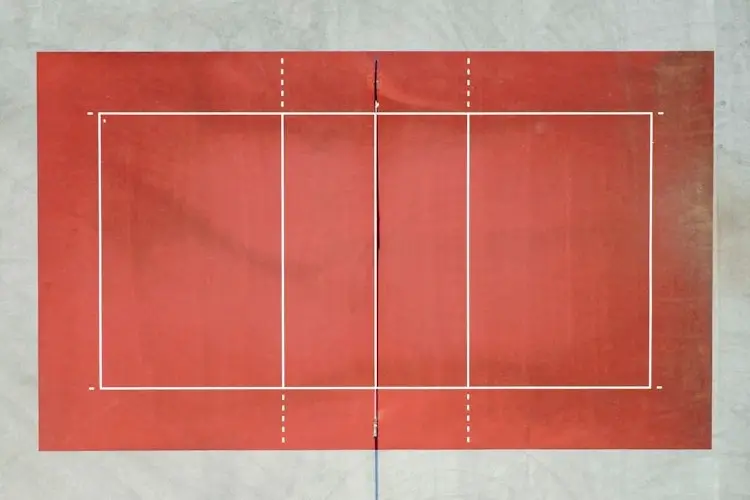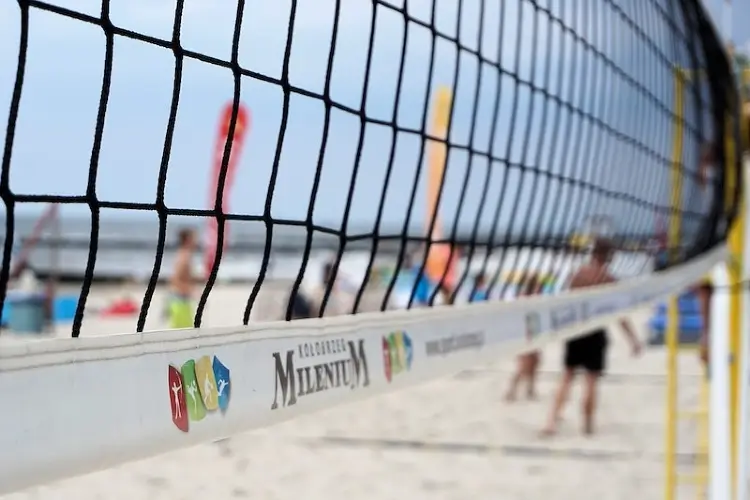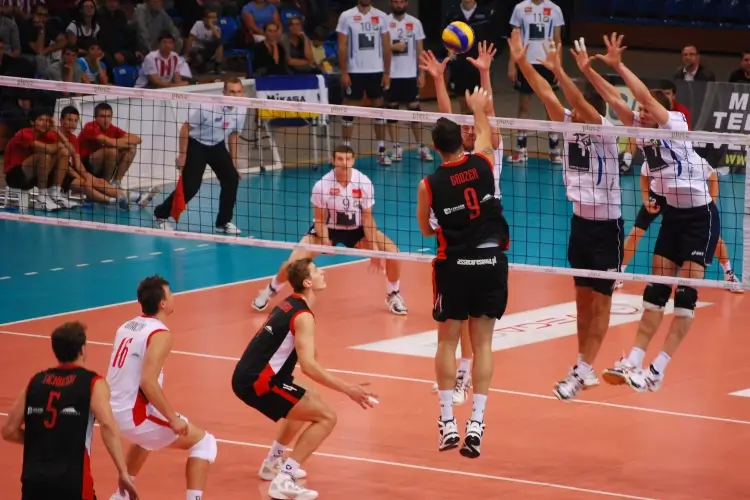Last Updated: September 25, 2023
Volleyball is played for recreational or professional reasons by people of different levels of skill. The internationally recognized and disciplined game is played as an indoor, beach (outdoors), or sitting sport.
If you want to enjoy the engaging sport to the fullest, there is equipment and gear you must have. The key things you need include appropriate attire, a net, and a court.
On personal gear, go for sportswear that is flexible, moisture-wicked, and provides adequate protection during the fast-paced game.
When setting a volleyball net, you use the official dimensions required for your specific category. The age and gender of the players also determine the height at which you install the net. For a play area, you may use a commercial or public play site on the volleyball court.
You can also set up a private court in your gym or backyard if you have guidelines. If you prefer to build a private court, I have also included the instructions below to help you.
Constructing a Volleyball Court

Measurements of a volleyball court
A volleyball court’s measurements depend on the players’ ages, gender, the league, and whether the court is meant for the beach, sitting, or indoor games. Before you start the installation process you first must know the specific measurements you will use. The dimensions may determine the cost and quantity of the resources you need to construct it.
Below are the official measurements of the various types of courts:
NFHS Indoor volleyball court
The National Federation of State High School Associations (NFHS) recommends that high school volleyball courts have standard measurements of 60 feet by 30 feet (18.29 meters by 9.14 meters). The length is 60 feet (18.29 meters), while the width is 30 feet (9.14 meters).
FIVB Indoor volleyball court
The International Federation of Volleyball (FIVB), the international body that sets rules and guidelines for volleyball, requires an indoor court to be 59 feet by 29.5 feet (18 meters by 9 meters) in size.
FIVB beach volleyball
According to FIVB, a beach volleyball court should have a length of 52.6 feet (16 meters) and a width of 26.25 feet (8 meters). The American Volleyball Association recommends the court have an extra free space of about 20 feet (6 meters). Adjacent courts can share the additional free space.
Recreational beach volleyball
A recreational beach volleyball court has a sandy surface court of 52.5 feet by 26.25 feet (16m x 8m). The court has defined end lines and sidelines to mark the play area’s length and width, respectively.
The free space all around the court is about three meters (9.8 feet) wide. A beach court is officially required to have a minimum dimensions of seven meters (23.0 feet). The sandy court should be leveled, and clear of any rocks, or tough debris that may injure players.
Suitable location
The first thing you need while constructing a volleyball court is a suitable location with adequate space. A spacious place will allow players to move around with ease. It’ll also be possible to have space for the audience and even a fence (if one’s needed). Choose a location where it will not interfere, or be disrupted by other activities.
Clear and level the site
Use professional sports construction companies that can adhere to the regulations. The construction process starts with the preparation of the space. If the land is raw, the clearing and leveling of the site may require heavy equipment such as a Bob Cat and rear-end loader.
The contractors clear and uproot any trees or bushes on eh land, then remove the topmost soil to exchange it with new. The ground is leveled to make the surface. A leveled court surface will improve players’ feet grip while in a game.
Install the drainage system
Your court needs a proper drainage system. Poor drainage may cause the court to retain water, hence forming muddy or sandy water pools. The drainage is installed before the sand mix court surface is done. The contractors can install a perforated drainage pipe around the entire court.
You can install an underlayment fabric that is strong enough to drain water from the sand surface. It is advisable to install an underlayment fabric of 8 ounces for the reasons below:
- Prevent sand losses, hence reducing continuous refills and court maintenance costs
- Ensure there is proper drainage from the sand surface
- Provide stability between the sand and gravel layers
Building the court surface
Most people prefer to have a court made of a sand surface. Be careful to choose suitable sand that also meets your preferences. Poor quality of sand may make the court dusty, or a rough surface that bruises players.
Get sand with low current and playing dust, and with minimal abrasiveness. There are several tests you can carry out at the sand supplier’s site to determine the quality and abrasiveness. Alternatively, you may use professionals to outsource quality materials and install the sand court surface.
Install a court of adequate depth that won’t need constant refills, and re-shoveling after every use. Once the court surface is complete, have the construction team install edges. Doing so prevents the sand from spreading out of the court to other places.
Fencing the court
You may fence the court to prevent the ball from going out. The fence also protects the audience from any stray shots. The wall is made of a net and evenly spaced poles. Invest in a strong and durable net that can endure players’ strong hits during the sports.
Professionals recommend the poles be made of treated wood, anodized aluminum, stainless steel, galvanized steel, or any other material that can endure tension to not break when stressed. Consider padding the poles to protect players from injuries and to enhance the aesthetics.
Volleyball Net

A volleyball net is one of the essential items you must have to play the game. The net is a critical feature as it provides a fair playing field for all the teams. A volleyball net installation is a simple task that requires only a few tools and instructions.
The regulatory bodies have different sizes for the outdoor, beach, men, women, youth, and sitting volleyball nets.
Follow the instructions below to put up your professional or recreational volleyball net:
Dimensions
To know the dimensions of a volleyball net, follow the steps below:
- Use an appropriate device like a net chain to take the measurements
- Ensure both sidelines of the net hang at the same height from the court surface, and on the sidelines
- Take the measurements at the center of the net
- Ensure the size of the net does not exceed the official measurement by above ¾ inches
- Take the measurement of a beach volleyball net when the sandy court is leveled
- When measuring an outdoor net on a surface that has grass, take measurements from the ground. Do not measure from the tips of the grass blades:
Indoor and beach nets
Volleyball regulatory bodies recommend that indoor and beach nets measure 32 feet long and 39 inches in height. The net heights differ depending on gender, age, and type of the league, among other factors. An outdoor net height for sitting volleyball will be different from the size of a standing outdoor game.
Men’s and women’s nets
Volleyball guidelines require men’s and women’s volleyball nets to measure between seven to 11 feet (2.43 to 3.43 meters) in height.
The standard size of a men’s net is 7.97 feet (2.43 meters), while a women’s net should be 7.35 feet (2.24 meters) high.
Youth volleyball net
Youth volleyball is a league for the young of 7 to 15 years.(1) The boy’s and girls’ teams use similar-sized nets with a height of seven feet (2.13 meters). However, younger girls of 10 years and below use a shorter net of six inches (1.98m).
Sitting volleyball net
Sitting volleyball is for the physically challenged players (with disability) who play while seated on the court. The game has a lower net than the height of regular volleyball sport.
Official regulations require the men’s sitting volleyball net to be 1.15 meters (3ft., 9.28 inches. The net for the women is required to be 1.05 meters (3ft., 5.34 inches) high.
Steps to install a net
Setting up and removing volleyball equipment is a regular task for sports officials that is easy if done correctly and as a team. The team requires skills to install or prepare the net for safe storage.
Most indoor nets are installed on floor sockets on the court surface while outdoor nets are installed on poles. The guidelines below will help you to set up an indoor, backyard, and beach volleyball net.
How to Install an Indoor Net
1. Remove the floor plates
An indoor volleyball net is secured with floorplates. You have to locate the floorplates to remove the covers. Use a flathead screwdriver, knife, coin, or any other appropriate item to open the lids. Confirm the holes are free of any debris or dirt.
2. Insert the poles
Hold up the poles in an upright position and gently slide them into the sockets. The poles should fit in the sockets to be firm and erect. Use safety pads to secure the poles better and prevent injuries.
3. Adjust the height
Once you secure the poles in their sockets, the second step is to adjust the height to the required measurements. The gender of the players, league, and type of the poles are some factors that will determine the size of the posts. Adjust the poles to match the required dimensions.
4. Attach the net
Unwrap and lay the net flat on the court surface between the two poles. If the net is twisted and cannot spread out, attach it on one side and untangle it as you spread it towards the other pole.
Use the net’s straps to tie the net to the post hooks on each pole’s lower side. Then, spread out the net through the winch leader strap.
5. Tighten and secure the net
Turn the witch leader strap handle clockwise to secure and tighten the net to the desired height. Ensure the center of the net is at the expected height to suit the set guidelines of the match, gender, and age.
6. Attach the straps
Once you have the net at the required height, attach, tighten, and secure the straps hanging from the middle and bottom of the net. Secure the straps on the poles horizontally parallel to the court floor.
You fasten the loose straps to prevent any injuries during a match. The straps also add to the net’s tension, ensuring the ball bounces back whenever it hits it.
7. Put up the antennas
Antennas help the match referees identify and rule on any faults during a match. The antennas mark the out-of-bound lines vertically and on top of the net.
Use clips or straps to secure the antennae once you set them up directly over the sidelines. Place the top hook of the antenna over the net, and attach and secure the lower position with a clip or clamp.
The indoor net is ready for use once you complete all the above sets.
Putting up a Backyard Volleyball Net
1. Prepare and mark play site
The volleyball outdoor net setup process normally uses a pre-measured and marked cord with post markers and four corner anchors. If you do not have a premeasured cord, measure a court play area that is 60 feet by 30 feet (18 m x 9.1 m) in length and width.
Level the play area to make the court safe and prevent the ball from rolling all over. Place the corner markers at their respective spots.
2. Spread the net
Unroll and spread the net at the center of the court. Insert the poles in the marked areas on the boundary lines of the court. Follow the net manufacturer’s instructions to slide the net over the posts.
3. Adjust the height of the poles
The poles may or may not have pre-marked levels for each net requirement. Some manufacturers add adjustable buttons or switches to set the required heights. Adjust the net to the required height.
4. Attach the guy line
Connect the swivel clips on the larger eye at the top of the outside pole, then attach them to the guy lines. Spread the guy lines away at eight to 12 feet or 45 degrees apart.
5. Install ground stakes
Before you fix the guy lines, have ground stakes hammered at the appropriate spots. Insert the guy lines’ loops into the ground stake for solid support.
6. Set up the posts
Once you have the guy lines fixed and have set the perfect height for the net, the final step is to set up the poles. Lift the poles upright, and pull down the guy lines to spread out the net. Adjust the two posts to straighten and center them for maximum net tension.
Steps to Set Up a Beach Volleyball Net
Setting up a beach volleyball net is almost similar to the indoor installation procedure. Regardless, the absence of the floor sockets on the beach court makes the installation different from the indoor setup.
In most instances, the beach courts have poles already installed at the play area. You may only need boundary markers to highlight the court outline.
After you outline the court surface, use the steps below to install the net:
- Make two holes in the marked spots
- Attach the guy lines, if you have them
- Insert the poles and adjust to the required dimensions
- Attach, tighten, and secure the net
- Fasten the net loops
- Fix the antennae if you have it
Recommended read: Volleyball Through Time: A Brief History You Should Know
Which Gear Do You Need to Play Volleyball?

Such a physically exerting sport requires comfortable and lightweight sportswear. It is essential you consider some factors as you choose what to wear for a volleyball match.
Let me go over the critical considerations for getting suitable volleyball sportswear.
Fabric of the uniform
Consider a fabric that has spandex since volleyball involves a lot of movement. A material that stretches can adjust to the players’ constant actions.
Choose a sportswear made with moisture-wicking material. The material will absorb the moisture, and will not get sticky with sweat.
Professional design
Invest in professionally designed sportswear that can endure the demands of a volleyball match. The design of the sports gear also brands a team. It is what the audience notices first, among other factors. A team may opt to have pre-made or tailored designs.
Also read: Point by Point – Demystifying Volleyball Scoring System
Footwear
Volleyball footwear quality depends on the age, gender, and level of a player. A beginner may usual ordinary runners’ sneakers, while a professional player should only use court shoes.
Court shoes provide a good floor grip and are comfortable for swift, repetitive, and aggressive movements. It is also possible to wear ankle braces to prevent ankle sprains when you have court shoes.
Ankle braces
The quick and repetitive volleyball game movements make limb injuries common in the sport. Players also land on each other’s feet as they block, dive, or spike the ball. The nature of the sport makes ankle sprains common. Players should wear ankle braces to protect the foot to prevent such injuries.
The brace prevents the ankles from twisting inwards or outwards. A pair of ankle braces should be stiff to keep the ankle in position and fit comfortably in the court shoes. The best braces extend past the ankle joint to the leg.
Knee pads
Knee pads are usually worn during indoor volleyball games that play on hard surfaces. The pads protect the knees from the impact of the court surface as they dive or pass the ball. The knee pads prevent floor bruises or burns. Purchase pads that are lightweight and breathable.
A good fit should be snug, cover the kneecap perfectly, and be comfortable on your knees. Try various movements like squatting when purchasing the pads. The try-out will ensure the size is not too tight or the design bulky behind the knee.
Socks
It is good a player puts on socks with the court shoes. The socks will protect against blisters caused by constant motion, moisture, and heat. An appropriate pair of socks should be breathable, fit perfectly, and wick moisture. Some players wear two pairs of socks to prevent any chances of friction against the skin.
Hydration gear
Volleyball is a physically demanding sport that causes players to sweat a lot. Having hydration gear ensures you have an adequate supply of fluids. Proper hydration keeps a player alert, prevents muscle cramps, and enhances the recovery process after a match.
Sun protection wear
It is essential to apply sunscreen and lip balm to prevent sunburns when in a beach volleyball or any other outdoor game setting. You can wear headgear with a brim to protect the face.
Wear sunglasses to protect the eyes from the sun and to avoid the glare from the sandy court and ocean water. Some players prefer to play in swimwear, while others opt for clothes that provide better protection against the sun.
Conclusion
Volleyball is a popular sport that may be played for recreational or professional purposes. Few official bodies govern the sport and regulate aspects such as volleyball courts and net dimensions.
The court, net, and gear guidelines depend on the league of the match, and the players’ age and gender. When installing a volleyball court, you must be conversant with the stipulated guidelines for each category.
A team can play a better match when in comfortable and protective gear that prevents injuries. Adhering to official guidelines elevates volleyball to a disciplined sport enjoyable to all parties.
